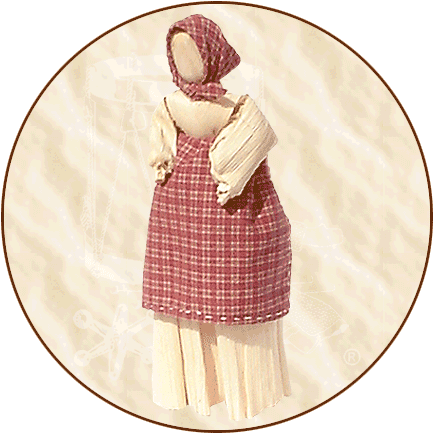.
Continued from product description on
Historical Doll Kits' Page Three...
Historical
Background: Corn began from a strain of the grass "teosinte"
and still grows wild in parts of Mexico. Some 6,000-year-old
corncob fossils exist that are only one-inch long and have less
than ten kernels! The Aztec, Maya, and Inca peoples began to
cultivate corn and, during the 1400s, corn growing spread to
Argentina, Chile, and Canada. The Navajo, Hopi, and Pueblos eventually
learned to grow corn. Christopher Columbus took seeds from Cuba
to Spain in 1492 and by the late 1500s, corn was growing in Africa,
Asia, southern Europe, and the Middle East.
Corn is also known as "maize." Corn is now one of
the world's most important crops. The United States produces
about two-fifths of the world's corn. Corn grows best in the
Corn Belt, a region of the American Midwest, which includes Iowa,
Illinois, Minnesota, Indiana, Nebraska, Ohio, Missouri, South
Dakota, and Kansas. Other major corn-producing countries include
Argentina, Brazil, China, France, Mexico, and Romania.
American colonists learned to grow corn from the Indians and
depended on corn as one their basic food staples during the 1600s
and 1700s. The Indians also taught these early settlers how to
make cornhusk dolls. The dolls could be made with corn husk clothing
or real fabric scraps; plus, other decorative ornaments could
be added to the corn husk doll to make it as beautiful as any
little girl wanted.
Native Americans did not waste any part of the corn. Cornstalks
were used for poles to support crops or as walking sticks or
kindling for fires. Corncobs were used to make pipes or soaked
in fat and used for fire starters. Cornhusks were also used to
weave mats and make dolls. Corn silk was used for healing teas.
The general idea that a doll would be a lasting toy is not
a belief of many Indian tribes. Even a very beautifully decorated
cornhusk doll would be expected to fall apart. A cornhusk doll,
like many playthings, would naturally disintegrate over time
and as the child grew older, he or she would no longer need the
toy anyway.
Some cornhusk dolls were used in sacred healing ceremonies.
An Iroquois cornhusk doll was made to carry away the evil spirit
of a dream, and the doll was later put back to earth after it
had served its purpose. The Oneida tribe has a legend about why
the cornhusk doll has no face. (See www.manataka.org/page67.html)
While making your own cornhusk doll, imagine yourself as a
Colonial settler's daughter who is being taught by a Native American
girl. Even though they may not have spoken the same language,
these girls could share in the tradition of making dolls together.













